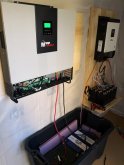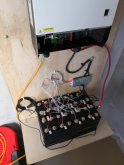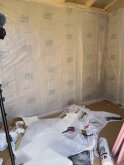You are using an out of date browser. It may not display this or other websites correctly.
You should upgrade or use an alternative browser.
You should upgrade or use an alternative browser.
My Solar Shed Construction Starts in a Week
- Thread starter Will Prowse
- Start date
D
Deleted member 783
Guest
Google "geothermal cooling" (or heating). I think that's what he means.
I knew what he meant, but he appears to think it's a viable alternative to a $149 AC unit, when in reality it costs a LOT more and will use the nearly the same amount of energy in the process. Plus you destroy your yard for a while, have to rent equipment, etc etc.
This system will level 2 charge my Tesla.
eddie1261
Solar Enthusiast
Is one of those MPPs a 12V or is that a 24 and a 48?
Both are 48v units. Super powerful.
D
Deleted member 783
Guest
So cool! I would reconsider the visquine. Google it, based on your climate. Might be too late, but it's not a big deal either way. Very happy for this thread! ??
eddie1261
Solar Enthusiast
Both are 48v units. Super powerful.
That slightly different form factor threw me.
No way!! I was told I need it for this environment. Dang it. What do you prefer instead?So cool! I would reconsider the visquine. Google it, based on your climate. Might be too late, but it's not a big deal either way. Very happy for this thread! ??
Ulmo
New Member
I was thinking rock wool insulation since it prevents fire from spreading. I don't know how useful it is to contain a fire in a shed that is going to burn anyway, but I'm just so used to installing rock wool everywhere that I use it everywhere anyway.Are you putting insulation in the shed? Some decent batts on the underside of the roof will certainly help keep the temp down when the sun is beating down.
Ulmo
New Member
I like the idea of a freestanding shed so it doesn't burn the house down. I agree with Will there. In my case, I would build it out of concrete, because we have other things that could catch fire around here, and I have been building concrete forms for years for work. But what I agree with you about is having the sloping roof toward where the solar panels go, all toward sun. However, I don't know what regulatory restrictions are there for solar panels mounted that way, i.e., covering the whole shed's roof. I play with the idea of building piers to move the four corners of a large panel of panels up and down to orient them at the sun all day, so maybe that would be different?Wouldn't a lean-to roof be better for solar?

Also, brainstorming, if you ever wanted to convert a wooden shed to concrete, you could put in the foundation ditch, rebar, concrete foundation and ground slab and a range of 0 to 2 adjoining walls, slide the wooden shed onto the pad, and finish surrounding it. Would need treated plywood or sheet metal to surround the wooden shed since untreated wood doesn't like concrete contact. Rebar, temporary form side, 4x4 braces inside, and poured-in-place 1' per half hour rises of concrete properly consolidated (vibrator), or cinderblocks (and concrete and rebar and vibrator) would both be options. Could upgrade an existing deteriorating shed into something much more fire resistant. Of course, you'd have to shore up the interior structures at some point so they don't fall down on old rotting wood, but with the fresh strong walls, you'd have all sorts of options.
I think your wood shed will last a while, though, very likely until you are an age when doing physical labor seems laborious.
Last edited:
Ulmo
New Member
I skimmed your post and thought you were recommending turning it into a refrigerator. I realize now that's not what you said. But here's how I replied when I still thought that, and it has some long references:Factor in 8 feet high and you have about 500 cubic feet. A 5000 BTU air conditioner will cool that to where you can keep vegetables in there and they won't spoil. That is about 1/3 the size of an average living room, and a 5000 BTU cools a living room well. My little trailer has AC in it as a STANDARD included item! It's 121 cubic feet and it has a 5000 BTU AC in it. As I am out there working on the trailer I have never had the Ac above 1 or 2!
He's fine for cooling. As smart as this kid is, he knows what he's doing.
According to this one hour presentation at
It would definitely be bad to have most Lithium Ion battery chemistries at refrigerator temperatures. While that is very dependent on the exact battery chemistry, that seems to be true with almost all the major ones available for storage projects that I am aware of so far.
Last edited:
D
Deleted member 783
Guest
No way!! I was told I need it for this environment. Dang it. What do you prefer instead?
I dont use it at all, but this is a short read that explains it well :

What Happens When You Put a Plastic Vapor Barrier in Your Wall? - Energy Vanguard
A lot of people have heard advice about vapor barriers and vapor retarders. Many of them have walked away confused. A big part of the problem, I think, is that they’ve been told what to do—”Put it on the warm-in-winter…
gnubie
Solar Wizard
- Joined
- Sep 20, 2019
- Messages
- 3,847
As a bit of colour, a lot of older of the houses here ( tropical east coast of australia ) have no insulation of any kind in the walls. Outside wall is a sheet of fibro (asbestos based sheeting), inside wall is a sheet of burnie board, a brown composite fibre board that warps at the slightest hint of water, a 10cm unsealed void between the two.
It's not at all unusual to see outside walls sweating during humid nights if the aircon is belting away inside. Despite that the burnie board doesn't warp and having seen inside the walls of enough renovations there isn't any water damage to speak of, at least not from the aircon condensing water out of the air. Looks like letting things dry out is a better approach?
It's not at all unusual to see outside walls sweating during humid nights if the aircon is belting away inside. Despite that the burnie board doesn't warp and having seen inside the walls of enough renovations there isn't any water damage to speak of, at least not from the aircon condensing water out of the air. Looks like letting things dry out is a better approach?
D
Deleted member 783
Guest
As a bit of colour, a lot of older of the houses here ( tropical east coast of australia ) have no insulation of any kind in the walls. Outside wall is a sheet of fibro (asbestos based sheeting), inside wall is a sheet of burnie board, a brown composite fibre board that warps at the slightest hint of water, a 10cm unsealed void between the two.
It's not at all unusual to see outside walls sweating during humid nights if the aircon is belting away inside. Despite that the burnie board doesn't warp and having seen inside the walls of enough renovations there isn't any water damage to speak of, at least not from the aircon condensing water out of the air. Looks like letting things dry out is a better approach?
Jeez what is humidity level there?
azdave85650
Livin Large in solar land
I'd insulate it and throw up 1/2" drywall, call it a day. If condensation/sweating is really the concern, use green board like bathrooms and kitchens.
:max_bytes(150000):strip_icc()/SPR-what-is-greenboard-drywall-1822831-hero_53588-7d1527ccfa43427f9d30b79685f95823.jpg)
 www.thespruce.com
www.thespruce.com
Maybe a whirlybird and soffits.
:max_bytes(150000):strip_icc()/SPR-what-is-greenboard-drywall-1822831-hero_53588-7d1527ccfa43427f9d30b79685f95823.jpg)
What Is Greenboard Drywall and How Is It Used?
Greenboard is an alternative to basic drywall for damp areas such as bathrooms, kitchens, and laundries, though unsuitable for shower tile installations.
Maybe a whirlybird and soffits.
Last edited:
Will very cool set-up. I am designing something very similar currently using the LV5048 as well, Post here: http://www.diysolarforum.com/index....00ah-lithium-iron-phosphate-battery-pack.509/ but I have a lot of indecision regarding my battery bank and to parallel first or series first, etc. What size LIFEP04 cells are those? And what is that BMS? I was thinking of using a DALY 16s 200AMP but I would love to know what yours is there. I am really excited to see what you end up doing with this project. Some insight on split phase would be useful as well. Keep up the great work!Insulating the shed and adding inverters
Batteries have cold temp protection and heater pad system. Need to add converters and outlets next. And ocpd and array. Lots of work to do.View attachment 869
I dont use it at all, but this is a short read that explains it well :

What Happens When You Put a Plastic Vapor Barrier in Your Wall? - Energy Vanguard
A lot of people have heard advice about vapor barriers and vapor retarders. Many of them have walked away confused. A big part of the problem, I think, is that they’ve been told what to do—”Put it on the warm-in-winter…www.energyvanguard.com
So according to that, the problem is when there is warm humid air outside, and the inside temp is air-conditioned below the dew point. Is it ever humid in Las Vegas?
azdave85650
Livin Large in solar land
It rarely, and I mean RARELY gets humid in Las Vegas.So according to that, the problem is when there is warm humid air outside, and the inside temp is air-conditioned below the dew point. Is it ever humid in Las Vegas?
It rarely, and I mean RARELY gets humid in Las Vegas.
Yeah, that was my thought. It has certainly felt dry every time I have visited. But I'm acclimated to coastal San Diego.
I know that Las Vegas can get quite cold (again, by my San Diego standards) in the winter, and that's where a good barrier might be important, but more to keep the cold dry air from getting in than to block moisture.
Around here, houses typically only have a moisture barrier on the outside, but I'm not sure what materials are typically used.
Similar threads
- Replies
- 4
- Views
- 213
- Replies
- 2
- Views
- 134






